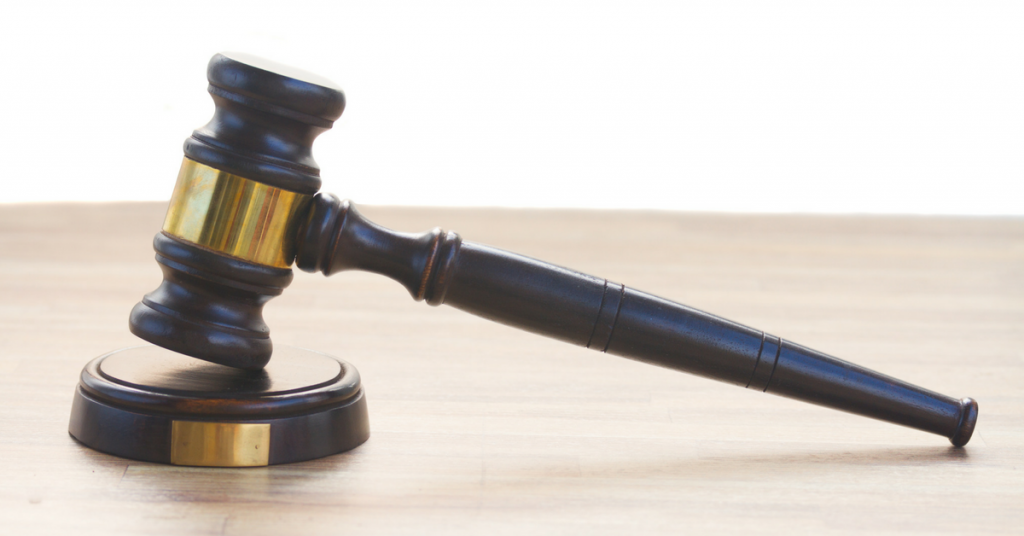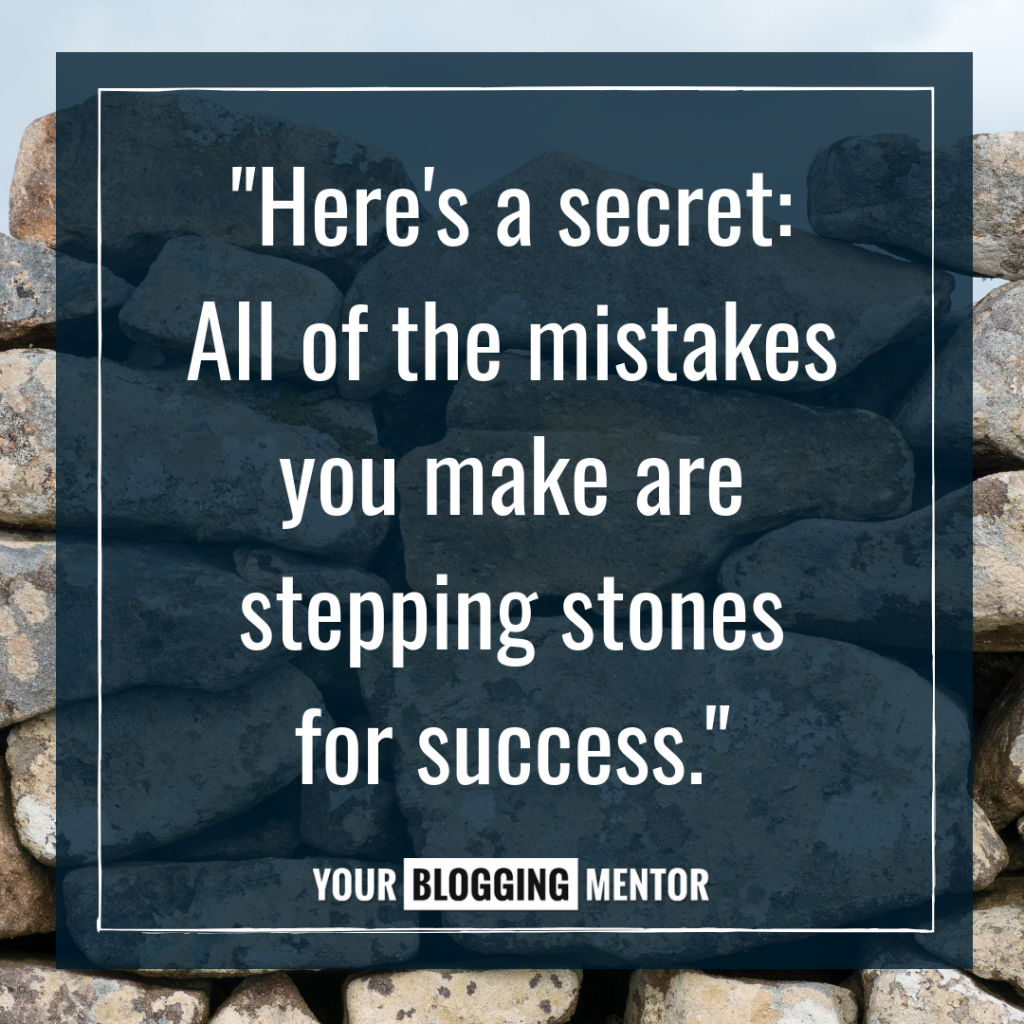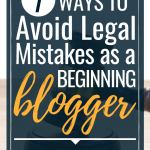
Jennifer recently wrote in with this question:
“I am such a rule follower and I’m so worried that I will do something wrong on my blog. Are there any basic legal things we should know about when first starting out?”
This is a great question and there are so many people I’ve talked to who want to start a blog but they’re so scared of doing the wrong thing or accidentally doing something illegal.
I want to give you 7 basic tips to help you avoid legal mistakes when you’re starting out as a blogger…
1. DON’T copy someone else’s content.
This is a very basic rule of thumb, but I think a lot of people don’t realize this when they’re first starting out.
When you write a blog post, it’s your original content — which means you own the copyright. It’s important to be careful that you don’t ever steal or infringe upon someone else’s original content on their blog.
If you want to share someone else’s content, stick to these few rules:
- Ask for permission from the blogger who owns the content.
- Highlight just an excerpt from the content (a paragraph or two) and put it in quotes.
- Always link back to the content where the full post can be found.
When you abide by these rules, you’re ensuring that you make it overtly clear the content is not your own.
2. DON’T copy someone else’s blog URL or blog design.
Just because the URL is available does not mean you aren’t still copying the domain name.
Do your research and be very careful that you’re not using a URL similar to someone else’s domain name.
(For example: I once had someone start a MoneySavingMoms.com site. Although the domain name was technically available, they were still using my name and simply adding an S to the end of it. We had to approach them and ask them to take it down.)
In the same vein, make sure not to copy someone else’s blog design or branding. Bloggers own their blog design and pay to have it done that way, so it’s really important not to copy it.
If you need more help with the ins and outs of branding, be sure to check out our course Branding Basics 101.
3. DON’T co-mingle funds.
Once you’ve set up a business and start earning money as a blogger, you should treat your business as a separate entity — in your mind and in how you run your finances.
From the get-go, it helps tremendously if you set up a separate business bank account and run all of your money through that.
At the end of each year, you’ll need to know how much money you brought in, how much you spent, and how much you owe in taxes. Having a separate bank account is the first step to staying financially organized.
You don’t need to set up an entirely separate business entity right away, but I do recommend doing this pretty soon after you start making consistent income from blogging.
4. DON’T use someone else’s photos without permission.
Treat all photos on someone else’s site as if they are copyrighted…because they most likely are.
There are tons of free stock photos available online that you can download and use without worrying about copyright. Here are some ideas:
If you haven’t paid for a photo, gotten expressed permission in writing, or used a free stock photo site…don’t use the photo!
This is SO important, because you can end up being invoiced for hundreds of dollars for using a photo that is copyrighted. Be very, very careful with this!
5. DO disclose affiliate relationships.
If you could potentially earn money from something you’re posting, you need to disclose that.
And the FTC is very, very picky about how you present disclosures. To be on the safe side, I recommend explicitly writing out your disclosure at the beginning of any post that you write. Here are some examples of disclosure we use frequently over at MoneySavingMom.com:
- “The links in this post are affiliate links, and we will be compensated when you make a purchase by clicking through our links.”
- “This post was sponsored by <<insert company name>>. All opinions are my own.”
- “This giveaway was sponsored by <<insert company name>> and the prize package was provided by them.”
- “I was given a free product to try out in exchange for this completely honest review. All opinions are my own.”
Basically, if you’ve gotten any form of compensation in return for putting something on the Internet, you need to disclose that in a very obvious place where people can see it easily.
I also recommend having a disclosure policy on your site that you can link to at the end of any of the disclosure examples above. (You can see our disclosure policy at MoneySavingMom.com here, as an example.)
6. DON’T send unsolicited e-mails.
You should never send someone e-mails if they aren’t on your email list. People have to decide on their own to sign up for your newsletter before you can start sending them emails.
And you should have a double opt-in set up for email list subscriptions. This means that readers are given two ways to confirm that want to actually be on your email list.
To ensure you have a double opt-in set up, make sure they have to sign up on your site and then that they also receive a confirmation email that they have to click on to confirm they’ve actually signed up for the newsletter.
Need help building an e-mail list? Check out our course Building Your List 101.
7. DON’T be afraid of making mistakes.
Now that I’ve given you all of these dos and don’ts, I know it can feel overwhelming and even a little bit scary that you might do something wrong.
Guess what? You will make mistakes! I’ve made tons of mistakes and you’re going to, too. It’s inevitable.
 But here’s a secret: all of the mistakes you make are stepping stones for success! I can look back on just about every mistake I’ve made — and even the mistakes I continue to make — and recognize what I’ve learned from each one.
But here’s a secret: all of the mistakes you make are stepping stones for success! I can look back on just about every mistake I’ve made — and even the mistakes I continue to make — and recognize what I’ve learned from each one.
Treat mistakes as learning opportunities! And also try to learn as much as you can from the people who have gone ahead of you and already made those mistakes.
That’s why we have this site. My heart is to help you avoid these kinds of things ahead of time and set you up for success as much as possible.
Do your research and do the best you can to avoid doing something illegal, but don’t let fear hold you back from stepping out and doing great things!
Jump out, experiment, try new things, and get brave. Be okay with failing, because it’s inevitable and that’s how you learn and grow!
Bloggers: What would you add to my list? Leave a comment and let us know!

DO set up social media accounts with your blog’s name, even if you don’t think you’ll be using that platform right now (like Tumblr).
YES!! Such a good one to add — thank you!
Hi,
Thank you for your work. I think you have addressed such an important topic today that keeps people from trying new things. Thank you!
I am unsure if it is okay to ask this or not, but would these same things apply to vlogging on Youtube?
I am looking at starting on Youtube first for free and then setting up a blog to direct people to later. (I own almost all of your blogging courses and look forward to utilizing them!)
It looks like there is only one opt-in with subscribing to Youtube videos, but I may be entirely wrong.
Thank you for your work as it is so appreciated by so many.
I was so thankful to find you had written about this topic! Thank you again!
Thanks for your encouragement! And yes, I’d say that most of what I wrote here would apply to vlogging, as well.
Thank you so much for the response and for the information! This is great to know. Thank you so much!
Thanks for sharing examples of disclosure policies. Figuring out how to do this is one thing that I’ve been putting off. I know I can’t go and copy someone else’s disclosure policy because of #1, so do you have any advice on the basic principles the disclosure policy needs to convey so I don’t get someone else’s words stuck in my head?! And you recommend a disclosure policy in a central spot on your blog as well as on each post with affiliate links? Lastly, are cookies different from a disclosure policy? I’ve noticed a pop-up for cookies on most sites these days. Is that automatic or is that something I have to create and publish? Thank you!
You are welcome to take my disclosure policy and rewrite it in your own words: https://moneysavingmom.com/disclosure-policy
I would link to your disclosure policy in your footer of your blog + in all posts that have affiliate links.
I think you’re thinking of a privacy policy vs. a disclosure policy. I would recommend having a privacy policy that you link in your footer and also you are supposed to link it in the footer of your email newsletter. You can read more about what to include in a privacy policy here: https://www.makeuseof.com/tag/write-privacy-policy-website/ (And there are free privacy policy generators here: https://digital.com/blog/best-privacy-policy-generators/)